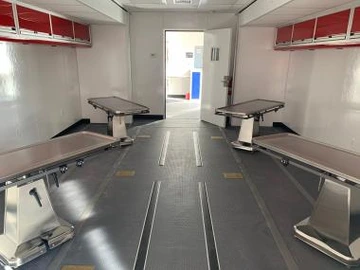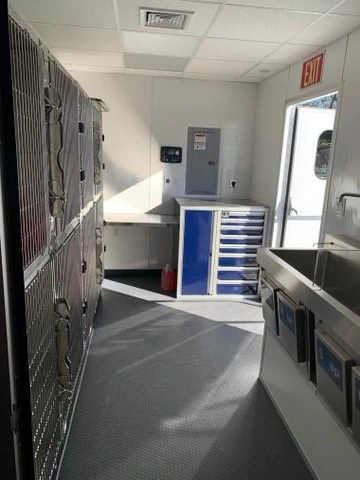A New Mobile Model of Care
At The University of Arizona College of Veterinary Medicine, our traditional teaching clinic is going mobile. Learn how we are embracing the future of veterinary education.

A New Mobile Model of Care
At the Arizona College of Veterinary Medicine, the traditional brick-and-mortar teaching clinic goes mobile and opens the door for veterinary students to serve their local communities and beyond.

There are myriad ways that The University of Arizona College of Veterinary Medicine is innovating the decades-old prototype for veterinary education, from its three-year format to the wellness components of its curriculum. But perhaps the most novel is the college’s pair of mobile clinics. One, a 53-foot surgery training unit and — soon to come — a smaller, nimbler unit that will travel around the state.
Why does this matter? Because not only do CVM’s mobile teaching clinics offer students a real-world education, but they also bring animal care directly to the communities that need it most.
“The mobile clinics are a marriage of providing care in areas of need throughout the state and training students,” says James H. Maciulla DVM, MBA, MS, Associate Dean. “That's a win-win for all of us.”
Here are five ways that CVM mobile clinics are changing the face of veterinary medicine.
1. Mobile Clinics Provide More Real-World Experience
Teaching hospitals often become specialized care facilities that are largely irrelevant to progressively building practical skills in DVM students, because surgeries are often more technical or out of the ordinary. As Maciulla notes: “Our goal is to create a skill-building, comfort-building paradigm of crawl, walk, run.” How it works: Students build skills in simulated labs before moving on to a full operating theater. Then, during their second year, they progress to the mobile clinic where they care for shelter animals in a rotation of high volume and repetition — i.e., an opportunity to hone their abilities. Mobile clinics provide the robust clinical and surgical foundation needed for students to move successfully into their clinical rotation year.
2. Mobile Clinics Boost the Number of Adoptable Animals
Mobile clinics provide an opportunity for students to support local shelters who are overworked and short staffed. There is a high correlation between the rate of euthanasia for shelter animals and the number of animals being “intact,” or not spayed or neutered. Shelters are unable to adopt out intact animals, and because of a shortage of spaying and neutering services, shelters hit capacity and are forced to start euthanizing healthy and otherwise adoptable animals. That’s where mobile clinics come in. “The use of mobile units has increased the number of animals adopted out by hundreds of thousands just because clinics are able to go to areas and provide these services,” says Maciulla.
3. Mobile Clinics Bring Care to Underserved Communities
One Health initiatives empowered by mobile clinics can provide more than spay and neuter services. Veterinary students can also assist with other elements of municipal needs, such as animal control and disease surveillance. CVM has a potential partnership with The University of Arizona College of Medicine, Phoenix, on a robust rural health care training platform in Payson and surrounding areas. “We'd like to get our clinical-year students in Payson, using the regional hospital as our affiliate, to embed students in needs specific to rural areas,” says Maciulla. “The College of Medicine is using local veterinarians to help train MDs, and now that we have a vet school, they’d like us to have a presence with our mobile clinic to elevate that by sharing expertise and collaborating.”

4. Mobile Clinics Empower Students to Rethink Traditional Business Models
As CVM students glean real-world training in a diverse range of communities, they will have the chance to reconsider how they approach their future profession. The experiences a mobile clinic offers restructure what a rural or high-need area veterinary practice could be and provides a starting picture of how a student could serve lesser populated and underserved communities. Explains Maciulla: “Students might ask themselves how they can make a business work in a rural area, what the needed services are, how they might continue to do mobile. They might consider working with the county or the city, or even doing telemedicine.”
5. Mobile Clinics Cut Costs and Support Local Practice
Building and managing a brick-and-mortar teaching hospital is expensive, and it pulls business from local practitioners in the surrounding communities. Mobile clinics, on the other hand, are less costly, more efficient and they support local practices by preparing students to be day-one-ready veterinarians ready to enter the field. Veterinary practices across the US are short-staffed and under pressure to provide services to their communities, and the College of Veterinary Medicine will produce students ready to work a year earlier than most. As Maciulla notes, “We're not here to compete. We're here to provide what you can't find, competent practitioners, to hire.”
Thank You to Our Partners
We’d like to recognize Nestlé Purina Petcare and Helen Rosen for their generous support for our mobile surgical suite. We are tremendously grateful for Nestlé Purina Petcare's involvement and their shared value for our students, faculty, and the communities we serve. Their commitment to our mobile unit will help develop our students' surgical skills and empower them with the tools of empathy and understanding to serve a broad social and economic continuum of animal owners and caregivers.
Learn More
See how Arizona College of Veterinary Medicine’s Doctor of Veterinary Medicine Program’s innovative curriculum prepares day-one ready practitioners.
